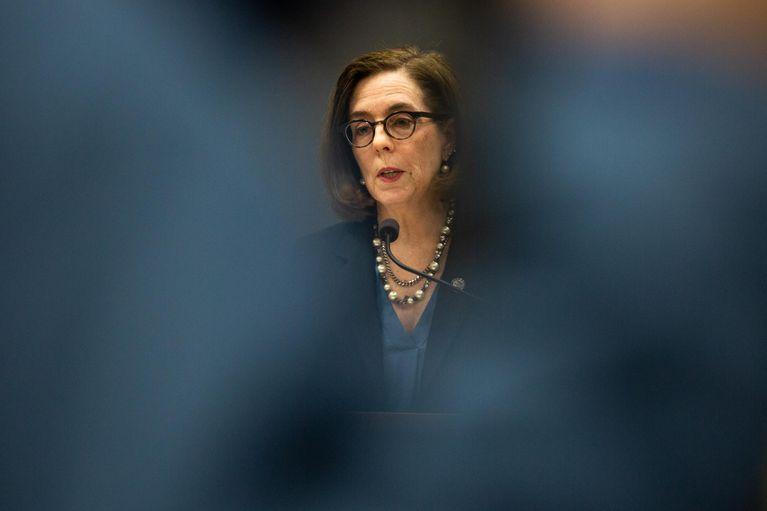
Gov. Kate Brown said Friday she will issue an executive order to ensure public school students get back into classrooms, a move that comes after nearly a year after she first ordered K-12 schools to close in response to the COVID-19 pandemic. All Oregon public schools must offer in-person instruction by the week of March 29 for students in kindergarten through fifth grade and the week of April 19 for students in sixth through 12th grades, Brown wrote in a letter to the Oregon Health Authority and Oregon Department of Education.
Under the directive, schools can still offer remote learning too. But all must offer at least some in-person learning, unless the spread of the virus is so severe in their geographic area that the state will make an exception. Many Oregon schools were already offering or planning to offer some in-person learning, prior to Brown’s Friday announcement.
"Thanks to the smart choices Oregonians have made, our COVID-19 numbers have declined. All but six counties now meet or exceed Oregon’s advisory metrics for a return to in-person, hybrid learning for all K-12 grade levels,” Brown said in a statement. "And, five of those counties meet the advisory metrics for a return to elementary school."
For Brown, reopening schools has been a key goal as she crafted the state’s vaccine rollout and how groups are prioritized for the limited doses provided by the federal government. Brown made K-12 teachers and school support staff and early childhood instructors eligible for vaccine doses before she opened vaccination to many senior citizens, saying the move was necessary so children can return to schools sooner. That controversial move put about 150,000 educators ahead of more than 700,000 seniors, a vulnerable group that has shouldered the majority of COVID-19 deaths. Subsequently, the state made all seniors age 65 and older eligible for vaccination.
“We have accelerated vaccinations for the educator workforce statewide,” Brown said in her letter to the Oregon Health Authority and Oregon Department of Education released Friday. “State and federal resources, including $500 million in federal funding in the last federal relief package, can be used to purchase personal protective equipment for educators, students, and staff, upgrade ventilation systems, and implement health and safety measures.”
Brown’s directive will require all public schools to be either fully on-site or offer a hybrid on-site/remote instructional model in counties that meet or exceed Oregon’s advisory metrics, which include factors like local case counts and infection rates. Students will be able to stay in distance learning if they wish. The exact blend of in-person and remote learning will vary from school to school and district to district.
Brown: In-person Schooling Is Safe
Brown encouraged in-person attendance.
“The science is very, very clear: with proper safety measures in place, there is a low risk of COVID-19 transmission in school,” Brown said. “Oregon parents can be confident about sending their children back to a classroom learning environment.”
State or local public health officials can still mandate exclusive distance learning when viral infection rates merit that, state officials said.
Brown’s goal is for schools to return to in-person or hybrid instruction by those dates, however. School districts that don’t return to at least some in-person instruction face potential state funding loss if they don’t comply.
“School districts that are not in compliance could ultimately face the loss of state school funds, but based on our office’s conversations with education leaders across the state, we don’t believe that will be necessary,” said Charles Boyle, spokesman for the governor’s office.
Boyle said many districts already have “concrete plans to return to in-person instruction.”
By March 19, the Oregon Health Authority and Oregon Department of Education will issue updated guidance to implement the policy set out by Brown on Friday.
Risk Level System Tweaked
Separately, Brown on Thursday changed the process that assigns risk levels to counties. Based on case counts, the four risk levels, which range from “extreme” to “lower,” guide how much counties can reopen businesses, restaurants, gyms and other facilities. Counties can improve or worsen, based on case counts, every two weeks when health officials look at the trendline. Starting next week, counties that face a move back to extreme risk will get two additional weeks to lower case numbers. The extreme risk level is harsh economically on businesses, and restaurants cannot allow indoor dining, for example.
The longer evaluation timeline is intended to give businesses a bit more certainty as they take potentially cumbersome and costly steps involved in opening up to more customers. However, counties that still have increasing case numbers after the two-week extension can move back to the extreme risk category.
The state will announce its next risk levels on Tuesday, which take effect on March 12.
You can reach Ben Botkin at [email protected] or via Twitter @BenBotkin1.